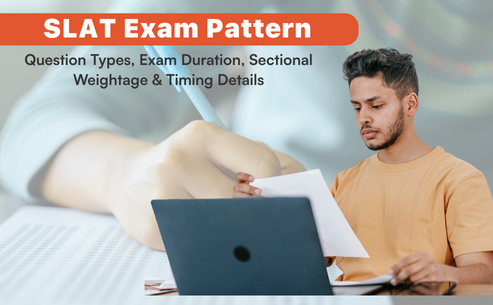The Symbiosis Law Admission Test (SLAT) 2026 is one of India’s most sought-after law entrance exams, offering admission into the prestigious Symbiosis Law Schools (SLS) at Pune, Noida, Hyderabad, and Nagpur. Every year, thousands of aspirants appear for this test with the dream of securing a seat in BA LLB (Hons.) or BBA LLB (Hons.) programs.
But here’s the catch: understanding the SLAT exam pattern 2026 is as important as knowing the syllabus itself. Why? Because the exam is not about rote learning or memorising lengthy legal provisions. Instead, it evaluates your ability to reason logically, analyse critically, comprehend quickly, and stay updated with current events.
The 2026 edition of SLAT comes with some significant changes and features that aspirants must be aware of:
- The Writing Ability Test (WAT) has been officially discontinued.
- Final admissions depend on your objective test score + Personal Interview (PI).
- The exam follows a balanced pattern with equal weightage to all five sections.
- Accurate and intelligent time management becomes your greatest strength with no negative marking or sectional cut-off.
This blog will serve as your complete guide to the SLAT exam pattern 2026, covering:
- Overall structure and marking scheme
- Sectional weightage and question types
- Exam timing and slot details
- Difficulty level and preparation insights
- What’s excluded from the exam in 2026
- Strategy to maximise your score
By the end, you’ll have a crystal-clear understanding of how to approach the SLAT 2026 exam confidently and strategically.
SLAT 2026 Exam Overview
The Symbiosis Law Admission Test (SLAT) 2026 is conducted by Symbiosis International (Deemed University) for admission into its five-year integrated law programs — BA LLB (Hons.) and BBA LLB (Hons.). Unlike other law entrance exams that rely heavily on mathematics or legal theory, SLAT adopts a balanced skill-based testing approach. It evaluates reasoning, comprehension, legal aptitude, and general awareness, making it accessible to aspirants from all academic backgrounds.
Here’s a quick snapshot of the SLAT exam pattern 2026:
| Feature | Details |
| Exam Name | Symbiosis Law Admission Test (SLAT) 2026 |
| Conducting Body | Symbiosis International (Deemed University) |
| Exam Level | Undergraduate |
| Courses Offered | BA LLB (Hons.), BBA LLB (Hons.) |
| Participating Institutes | SLS Pune, SLS Noida, SLS Hyderabad, SLS Nagpur |
| Mode of Examination | Computer-Based Test (Online) |
| Medium | English |
| Total Duration | 60 minutes (1 hour) |
| Total Questions | 60 |
| Total Marks | 60 |
| Question Type | Multiple-Choice Questions (MCQs) |
| Marking Scheme | +1 mark for each correct answer |
| Negative Marking | None |
| Additional Component | Personal Interview (PI) |
| Writing Ability Test (WAT) | Discontinued from 2026 |
Key Takeaway: SLAT 2026 tests your aptitude across five equally weighted sections. With no negative marking and no sectional cut-offs, you are encouraged to attempt all 60 questions. Final selection depends on both your exam score and Personal Interview performance.
SLAT 2026 Paper Pattern at a Glance
To crack SLAT 2026, aspirants must first understand the core structure of the exam. The paper tests speed, accuracy, and reasoning ability under time pressure. Unlike CLAT or AILET, SLAT follows a student-friendly pattern with no negative marking and equal focus across all sections.
Here’s a quick look at the SLAT exam pattern 2026:
| Feature | Details |
| Exam Mode | Computer-Based Test (Online) |
| Type of Questions | Multiple-Choice Questions (MCQs) |
| Number of Sections | 5 (Logical Reasoning, Legal Reasoning, Analytical Reasoning, Reading Comprehension, General Knowledge) |
| Total Questions | 60 (12 questions per section) |
| Total Marks | 60 |
| Duration | 60 minutes (1 hour) |
| Marks per Question | +1 |
| Negative Marking | None |
| Language of Paper | English |
| Additional Component | Personal Interview (PI) |
| WAT (Essay Writing) | Removed from 2026 onwards |
Key Highlight: Since there is no sectional timing, you can navigate between sections and attempt questions in any order during the exam. This flexibility helps you play to your strengths.
SLAT 2026 Section-Wise Weightage & Question Distribution
The SLAT exam pattern 2026 ensures balanced testing across five skill areas — reasoning, legal aptitude, reading ability, and general awareness. Unlike other exams where one section dominates, SLAT gives equal weightage to all five sections, with 12 questions each.
This uniform distribution means you cannot afford to ignore any section. Strong performance across all areas is the only way to maximise your overall score.
Section-Wise Breakdown of SLAT 2026
| Section | No. of Questions | Marks | Key Focus Areas |
| Logical Reasoning | 12 | 12 | Arguments, assumptions, conclusions, puzzles, coding-decoding |
| Legal Reasoning | 12 | 12 | Principle–fact based questions, application of legal rules (no prior legal knowledge required) |
| Analytical Reasoning | 12 | 12 | Series, blood relations, data interpretation, number & logic puzzles |
| Reading Comprehension | 12 | 12 | Short passages, vocabulary in context, inference, tone, central idea |
| General Knowledge (Current & Static) | 12 | 12 | National & international current affairs, polity, history, awards, sports, science & tech |
Key Highlights
- Equal Weightage: Each section contributes exactly 20% of the paper.
- No Sectional Time Limit: You can switch between sections within 60 minutes.
- Balanced Skills Tested:
- Reasoning-based → Logical & Analytical Reasoning
- Language-based → Reading Comprehension
- Awareness-based → General Knowledge
- Domain-based → Legal Reasoning (beginner-friendly)
Pro Tip: Legal Reasoning is not about memorising laws but applying logic to principles. Even students from non-law backgrounds can score well with consistent practice.
SLAT 2026 Exam Timing & Slot Details
The SLAT exam pattern 2026 follows a one-hour computer-based test (CBT) format conducted across designated centres in India. Aspirants must strictly adhere to reporting and test timings since no late entries are allowed once the exam begins.
Based on official updates and past exam trends, here’s what you can expect for SLAT 2026:
Tentative Exam Slot Information
| Particular | Expected Details |
| Exam Date | December 20, 2025 (Test 1) & December 28, 2025 (Test 2) |
| Mode of Exam | Computer-Based Test (Online at test centres) |
| Test Duration | 60 minutes (1 hour) |
| Exam Window | Two slots (morning & afternoon expected) |
| Reporting Time | At least 60 minutes before exam commencement |
| Likely Start Time | Between 9:00 AM – 10:30 AM (to be confirmed by admit card) |
| End Time | Exactly 60 minutes from the start time (auto-submission) |
Important Timing Guidelines for SLAT Aspirants
- Arrive Early: Reach your test centre at least 1 hour before the exam to complete ID and biometric verification.
- Strict Timer: Once you start, the system auto-triggers the 60-minute timer. No grace time will be given.
- Free Navigation: Since no sectional timing exists, you can move between sections freely during the exam.
- Admit Card: Carry a clear printout of your admit card, a valid photo ID, and a recent photograph for verification.
Post-Exam Process
After the objective test, candidates are shortlisted for the Personal Interview (PI) round. Both SLAT score and PI performance are combined for the final merit list.
Key Tip: If you opt for both Test 1 and Test 2, the higher score will be considered for selection.
SLAT 2026 Question Style & Difficulty Level
Knowing the question style and difficulty level is as essential as knowing the syllabus. While SLAT is considered more student-friendly than CLAT or AILET, it still demands speed, logical thinking, and accuracy under time pressure.
Here’s a section-wise breakdown of question types and difficulty levels you can expect in SLAT 2026:
| Section | Question Style | Difficulty Level |
| Logical Reasoning | Assumption–conclusion, statement–argument, coding–decoding, logical sequences, puzzles | Moderate |
| Legal Reasoning | Principle–fact based questions where you apply legal principles to given scenarios (no prior law required) | Moderate |
| Analytical Reasoning | Blood relations, number series, direction sense, data interpretation, puzzles & arrangements | Easy to Moderate |
| Reading Comprehension | 2–3 short to medium passages (200–300 words), vocabulary in context, inference, tone, central idea | Moderate (time-sensitive) |
| General Knowledge | Static GK (Polity, History, Geography), Current Affairs (past 8–10 months), awards, events | Moderate (if updated) |
Key Observations
- Legal Reasoning is beginner-friendly: Questions are principle-application based, not memory-heavy.
- Reading Comprehension: Usually 2–3 short passages, each followed by 3–5 questions.
- GK Advantage: Well-prepared candidates can answer quickly and save time for tougher sections.
- Overall Difficulty: Moderate – designed to be accessible for students from all academic streams.
Pro Tips for SLAT 2026
- Practice mock tests in real time — 60 questions in 60 minutes.
- Build reading speed & comprehension accuracy to excel in RC and GK.
- For reasoning sections, avoid blind guessing — even though there’s no negative marking, time wasted on random attempts can cost you marks.
- Stay updated on current affairs (last 8–10 months) — this section is a quick score booster.
What’s NOT in SLAT 2026?
While knowing what SLAT tests are essential, it’s equally crucial to understand what they don’t include. Awareness of exclusions helps aspirants save valuable prep time and focus only on relevant areas.
Here’s a clear list of what’s not part of the SLAT exam pattern 2026:
| Component | Explanation |
| Quantitative Aptitude / Maths | SLAT does not have a separate Mathematics section. Only basic numerical reasoning (ratios, percentages, DI) may appear under Analytical Reasoning. |
| Sectional Time Limits | There are no fixed time limits per section. You can switch freely between all five sections within 60 minutes. |
| Negative Marking | Wrong answers do not attract penalties. However, careless guessing wastes time. |
| Writing Ability Test (WAT) | The essay-writing component has been officially discontinued from 2026. Only objective MCQs + PI are part of the selection. |
| Offline Mode | The exam is strictly Computer-Based (CBT). No pen-and-paper option is available. |
| Assertion–Reason MCQs | Unlike AILET, SLAT avoids complex formats such as assertion–reason type questions. |
Common Mistakes to Avoid
- Don’t spend time on advanced Math topics like Algebra, Profit & Loss, Time-Speed-Distance, etc.
- Don’t over-prepare legal theory — SLAT tests principle-application, not memory.
- Don’t prepare for essay writing — the WAT is removed.
- Don’t expect lengthy legal comprehension passages — Legal Reasoning is usually caselet-based and concise.
Smart Prep Tip: Focus only on the five tested sections — Logical, Legal, Analytical Reasoning, Reading Comprehension, and GK. Cutting out irrelevant topics will save hours and sharpen your preparation.
Preparation Strategy Based on Paper Pattern
Cracking the SLAT exam pattern 2026 isn’t about studying everything under the sun — it’s about strategic preparation. Since all five sections carry equal weightage, a balanced approach is non-negotiable. The goal is to maximise accuracy while managing time efficiently.
Section-Wise Preparation Tips
| Section | Strategy |
| Logical Reasoning | Practice syllogisms, statements–assumptions, and puzzles daily. Focus on eliminating wrong options logically. |
| Legal Reasoning | Work on principle–fact based questions. Don’t rote-learn laws — instead, learn how to apply rules to scenarios. |
| Analytical Reasoning | Strengthen basics in series, blood relations, DI sets, ratios & percentages. Practice timed problem-solving for speed. |
| Reading Comprehension | Read editorials from The Hindu or Indian Express. Practice tone detection, inference, and central idea questions. |
| General Knowledge | Revise static GK weekly and cover 8–10 months of current affairs (national + international). Use monthly digests. |
Time Management Strategy
Since SLAT 2026 has no sectional time limits, you can allocate time flexibly. A smart approach is:
| Section | Suggested Time |
| Logical Reasoning | ~14 minutes |
| Legal Reasoning | ~14 minutes |
| Analytical Reasoning | ~14 minutes |
| Reading Comprehension | ~13 minutes |
| General Knowledge | ~5 minutes |
Pro Tips:
- Start with your strongest section to build confidence.
- Don’t spend more than 1 minute per question — move on and return later if time permits.
- Attempt all 60 questions (no negative marking).
Mock Tests & Practice
- Solve at least 15–20 full-length mock tests before exam day.
- Take sectional tests with a timer to build speed and stamina.
- After every mock, analyse mistakes and rework weak areas.
- For RC and GK, practice daily reading + weekly revisions.
Recommended Resources
| Section | Resources |
| Legal & Logical Reasoning | Universal’s CLAT Guide, RS Aggarwal (Reasoning), Online mock tests |
| Analytical Reasoning | Quantitative Aptitude (Arun Sharma – selected chapters), DI practice sets |
| Reading Comprehension | The Hindu Editorials, Oliveboard/Gradeup RC sets |
| General Knowledge | Lucent GK, Manorama Yearbook, Tarkashastra GK Capsules, AffairsCloud Monthly |
Key Strategy: Consistency beats cramming. Just 3–4 hours of daily prep for 3–4 months, combined with mock practice, can give you a strong edge in SLAT 2026.
SLAT 2026 Scoring & Final Selection Process
Unlike other law entrance tests, the SLAT exam pattern 2026 follows a transparent and straightforward scoring system. Every correct answer carries +1 mark, and there is no negative marking. However, your admission doesn’t depend on the objective test alone — the combined score of SLAT + PI determines your final selection.
SLAT 2026 Scoring Overview
| Component | Maximum Marks | Weightage in Final Selection |
| SLAT (Objective Test) | 60 marks | Scaled up to 70 marks |
| Personal Interview (PI) | 30 marks | 30 marks |
| Writing Ability Test (WAT) | Not applicable in 2026 | Discontinued |
Key Points to Remember
- Each correct answer = +1 mark.
- No penalty for wrong or unattempted answers.
- Your raw score out of 60 is scaled up to 70 for the final merit calculation.
- Final selection list = SLAT Score (70) + PI Score (30).
- Performing well in the PI is crucial, even if you score high in SLAT.
Why Does PI Matters?
The Personal Interview round assesses:
- Communication & confidence.
- Awareness of current events and legal issues.
- Clarity of thought & motivation for pursuing law.
- Personality, ethics, and overall suitability for law school.
Pro Tip: Don’t ignore PI preparation — it carries 30% weightage and can decide between candidates with similar SLAT scores.
Conclusion
The SLAT exam pattern 2026 is designed to evaluate not what you have memorised, but how you think, analyse, and stay informed. With 60 questions in 60 minutes, equal sectional weightage, and no negative marking, SLAT is a balanced and student-friendly exam compared to CLAT or AILET.
Key takeaways for aspirants:
- 5 Sections, Equal Weightage: Logical Reasoning, Legal Reasoning, Analytical Reasoning, Reading Comprehension, and General Knowledge — each carries 12 marks.
- No Negative Marking & No Sectional Timing: Attempt all questions confidently and manage time as per your strengths.
- WAT Discontinued: Final selection depends on your SLAT score + PI performance.
- Difficulty Level: Moderate — designed for students from all academic streams.
- Preparation Focus: Prioritise consistent practice, timed mocks, and regular current affairs updates.
At Tarkashastra, strategy is as important as hard work. Our expert mentors guide aspirants in mastering reasoning, staying updated with GK, improving reading skills, and preparing for the all-important PI round.
With the right plan, SLAT 2026 can be cracked with confidence.
Start early, stay consistent, and remember — in SLAT, it’s not about attempting more, it’s about attempting smart.
FAQs on SLAT Exam Pattern 2026
1. What is the exam pattern of SLAT 2026?
SLAT 2026 consists of 60 multiple-choice questions to be solved in 60 minutes. The paper has five sections, each with 12 marks and no negative marking.
2. How many sections are there in SLAT 2026?
There are five sections — Logical Reasoning, Legal Reasoning, Analytical Reasoning, Reading Comprehension, and General Knowledge. All are equally weighted.
3. Is there any negative marking in SLAT 2026?
No, SLAT 2026 has no negative marking. Candidates are encouraged to attempt all 60 questions without the fear of losing marks.
4. How long is the SLAT 2026 exam?
The exam duration is 60 minutes (1 hour). Candidates must manage time carefully since there is no sectional timing.
5. What is the marking scheme in SLAT 2026?
Each correct answer carries +1 mark. There is no penalty for wrong or unattempted answers.
6. Is the Writing Ability Test (WAT) part of SLAT 2026?
No, the WAT has been discontinued from SLAT 2026 onwards. Final selection is based only on the objective test and PI.
7. What is the role of the Personal Interview (PI) in SLAT?
The PI carries 30 marks and evaluates communication, confidence, awareness, and motivation for law. It is crucial for the final selection.
8. Can I appear for both SLAT Test 1 and Test 2?
Yes, candidates may appear for both. If attempted twice, the higher score is considered for admission.
9. How many questions are asked from each section in SLAT 2026?
Each section has 12 questions, comprising 60 questions across five sections.
10. What type of questions are asked in the Legal Reasoning section?
Questions are mostly principle–fact-based, where you apply a given rule to a situation. No prior legal knowledge is required.
11. Does SLAT 2026 include Mathematics?
No dedicated Maths section is included. Only basic numerical reasoning appears under Analytical Reasoning (like ratios, percentages, DI).
12. What is the difficulty level of SLAT compared to CLAT or AILET?
SLAT is considered moderate and more student-friendly. Rather than deep legal or advanced math concepts, it focuses on aptitude and comprehension.
13. Is there any sectional cut-off in SLAT 2026?
No, there are no sectional cut-offs. Selection is based on your overall SLAT score combined with PI performance.
14. Can I skip a question and return to it later in SLAT?
Since there are no sectional limits, you can freely navigate between sections and revisit unanswered questions.
15. Are calculators allowed in SLAT 2026?
No, calculators are not permitted. However, rough sheets are usually provided for reasoning-based problems.
16. What is the exam mode for SLAT 2026?
The exam is conducted as a Computer-Based Test (CBT) in designated centres across India.
17. What is the weightage of PI in the final selection?
The PI carries 30% weightage, while the SLAT objective test is scaled to 70 marks. Combined, they decide on final admission.
18. Are all SLAT 2026 questions multiple-choice?
Yes, all questions are MCQs with four or five options. Only one answer is correct for each.
19. What is the expected timing of the SLAT 2026 exam?
The exam will be conducted in one of the two slots (morning and afternoon). The exact time will be mentioned on your admit card.
20. Which law schools accept SLAT scores?
SLAT scores are accepted by four Symbiosis Law Schools: Pune, Noida, Hyderabad, and Nagpur.
21. How many marks should I aim for to clear SLAT comfortably?
While cut-offs vary, aiming for 45+ marks with accuracy usually ensures shortlisting for PI.
22. How many mock tests should I take before SLAT?
Experts recommend solving at least 15–20 full-length mock tests before the exam to build speed and accuracy.
23. Is SLAT conducted more than once a year?
SLAT is held once a year, but in two phases (Test 1 & Test 2). You can choose one or both.
24. Is prior knowledge of law necessary for SLAT?
No, prior legal knowledge is not required. SLAT tests your ability to apply simple principles logically.
25. How is the final merit list prepared in SLAT 2026?
The final merit list is based on the scaled SLAT (70 marks) and PI (30 marks) scores. WAT is not considered in 2026.







